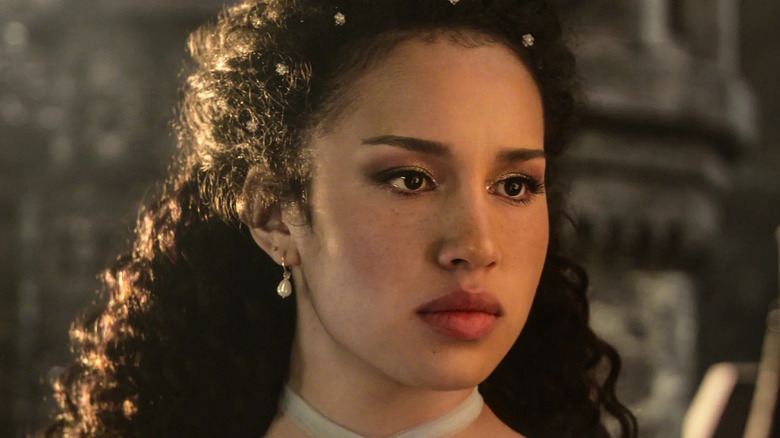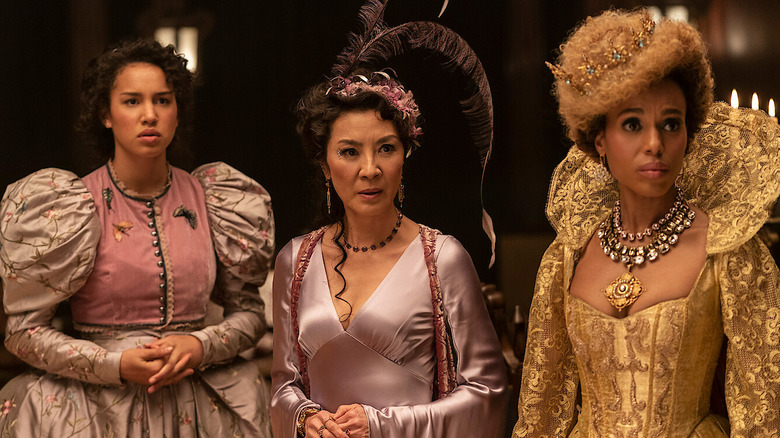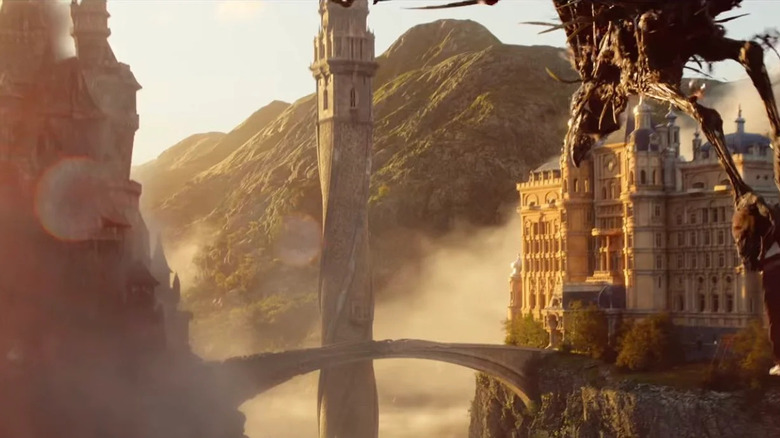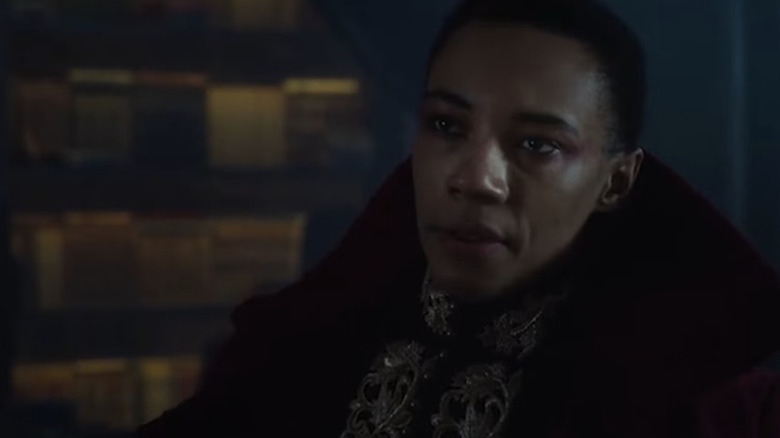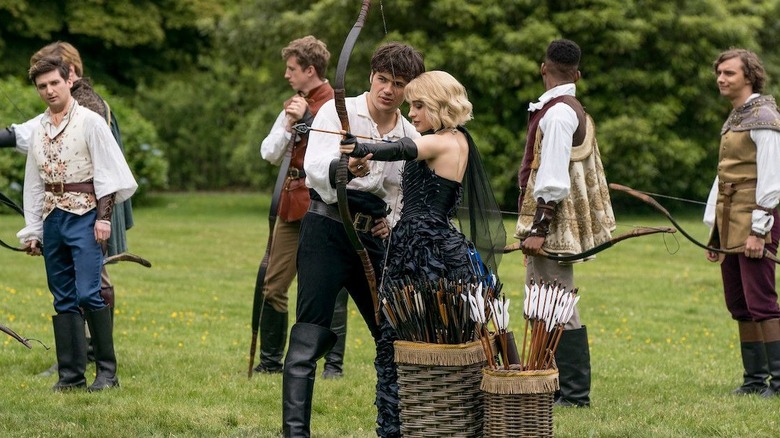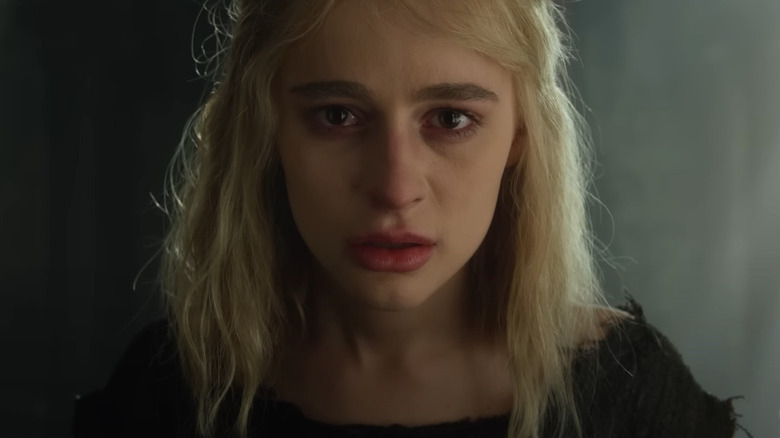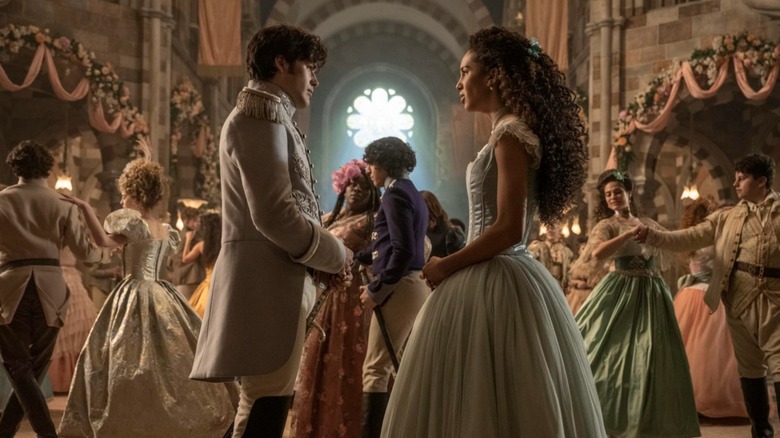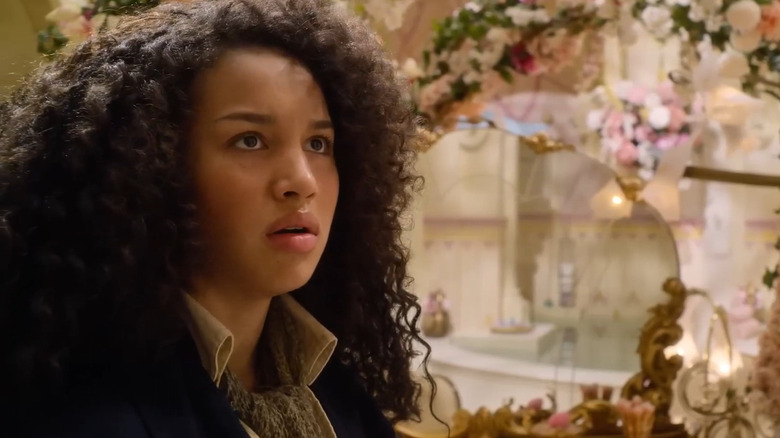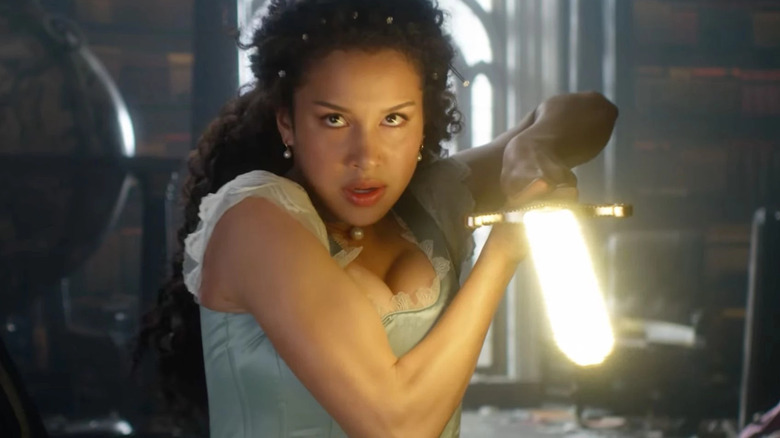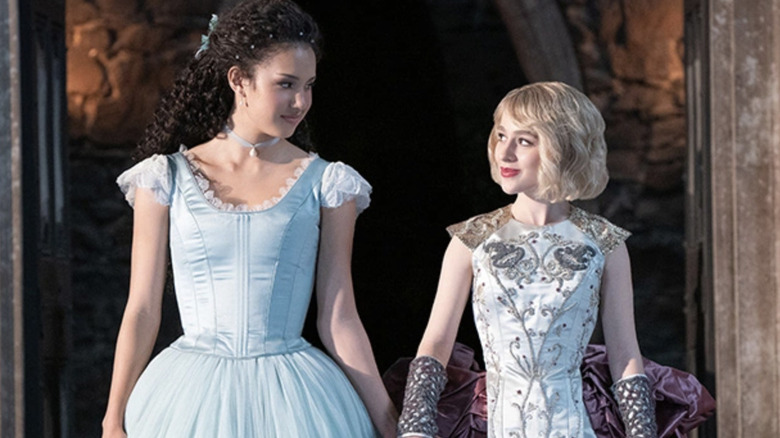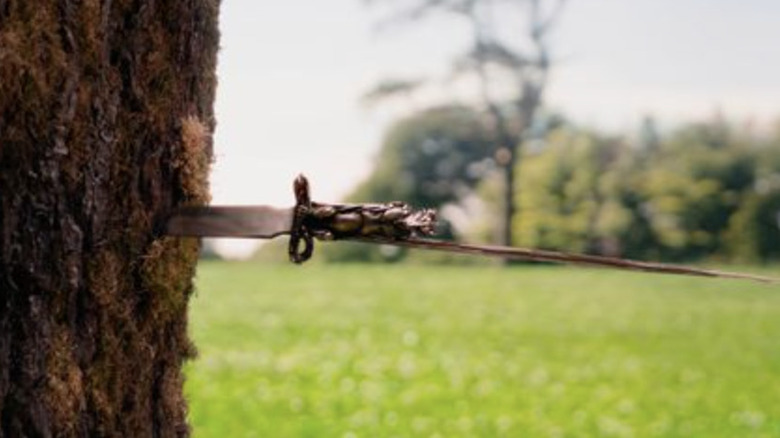The School For Good And Evil's Biggest Differences From The Books Explained
Based on the fairytale fantasy novel by author Soman Chainani, Netflix's "The School for Good and Evil" follows the story of best friends Agatha and Sophie. In the book, Sophie dreams of attending the School for Good and Evil, believing that, as a good person, she'll receive the fairy tale ending she deserves. However, upon arriving at the school, it's her moody best friend Agatha who's brought to the School for Good, while Sophie must come to terms with the more evil aspects of her own nature.
Of course, any author will need to accept that adaptation means changes to the source material, and this is something that author Chainani understood. In an interview with Cosmopolitan, director Paul Feig detailed the process of deciding which specific plot points from the novel to include in the film, arguing that if they'd everything from the novel, the film would have been much longer and more expensive than the budget allowed. Chainani told Radio Times that he was actively involved in the film's production, and understood the need for specific changes in the adaptation. "Only a foolish author would insist on a slavish translation that speaks to no one but the most literal of readers," the author said. "A reader's imagination is usually much more vivid and precise than anything that can be put on screen."
With that in mind, let's take a look at some of the biggest differences between the fantasy novel "The School for Good and Evil" and the Netflix film adaptation from Paul Feig.
More diversity
When "Bridgerton" arrived on Netflix in 2020, it was immediately clear that Shonda Rhimes had created a colorful and romantic period drama set in a version of Regency-era London rich with cultural diversity. While there are a few people whose heads might turn at the apparent "color-blind" attitude that the series portrays, this form of racial diversity is generally celebrated (via Vox). Now it seems as though the film adaptation of "The School for Good and Evil" is following suit, by populating a classic fantasy setting with a wider variety of skin colors than one might associate with the genre.
Of course, you can't literally see the characters on the page in Soman Chainani's book, and it's understandable if many readers, in their mind's eye, default to the fair-skinned royalty of fairy tale tropes. But Paul Feig and company have assembled a cast of actors from a wide range of backgrounds, with a diverse array of faces and a variety of ages, all coming together beautifully to create the movie's unique world. And with big names like Laurence Fishburne, Michelle Yeoh, Kerry Washington, and Charlize Theron attached to the project, you know that audiences are going to see top tier talent bringing Chainani's world to life.
School enrollment is different
In the film, Sophie and Agatha first hear about the School for Good and Evil as a whisper. Sophie loves reading old fairy tales over and over again, and when she takes Agatha to her favorite bookstore, the shopkeeper tells the girls about the conspiracy surrounding this mysterious school they've never heard of. She even tells them about a young girl who disappeared from their village years prior, suggesting that girl was brought to the School for Good and Evil.
This drives Sophie to write a letter to the school, inquiring about enrollment. Unfortunately for her, Agatha intervenes when she's about to be taken to the school, and both girls are brought to the magical land. Much to Sophie's dismay, she's brought to the School for Evil while Agatha is dropped off at the School for Good.
Enrollment works a little differently in the book. Every four years, two children from Sophie and Agatha's village of Gavaldon are taken against their will to be enrolled in the School for Good and Evil. Eventually, Gavaldon is given a new fairytale book that showcases the stories of their stolen children. Growing up with this information makes Sophie dream of being taken away to become a princess. On the day of the kidnapping in their village, both Sophie and Agatha are selected as they're both destined to be at the school. Agatha becomes an "Ever" at the School for Good, while Sophie becomes a "Never" at the School for Evil.
The history of the two brothers
The opening sequence of "The School for Good and Evil" showcases a fight between two twin brothers, Rafal and Rhian. Rafal is the School Master for Evil while Rhian is the School Master for Good. The two brothers are able to keep the balance between good and evil as their love for each other outweighs their nature to fight one another. Together they can achieve immortality. However, Rafal taps into the outlawed use of blood magic, resulting in Rhian needing to stop his brother — seemingly killing him in the process.
This story is common knowledge for the staff at the School for Good and Evil. Everyone knows that Rhian defeated his brother all those years ago and that with his brother gone, he has aged into an older man and acts as the only School Master. However, by the end of the film, it's revealed that Rafal actually defeated his brother and assumed his identity, deliberately weakening the School for Good in order to gain control.
In the novel, things go a little differently. While the fight between the brothers is common knowledge, no one really knows which of the School Masters actually won. However, it's assumed that Rhian, the School Master for Good, was victorious, as the School for Good has continued to beat Evil in the school conquests through the years.
The truth behind finding true love's kiss
Throughout the film, Sophie is adamant that she's been placed in the wrong school. She believes that she belongs in the School for Good rather than being dropped off in the School for Evil. Meanwhile, Agatha finds both schools to be outdated, arguing that no person is completely good or evil and insisting that she just wants to go back home to Gavaldon with Sophie. She believes if she can get the schools to see that Sophie belongs in the School for Good, her best friend will leave with her.
She discovers how to get into the School Master's tower, where the two girls air their grievances about their situations. The School Master tells them that if they can prove that Sophie is good then she will be switched to the other school. He also reveals that the reason the students at School for Evil are called "Nevers" is because they never get to live happily ever after with their true love. If Sophie can find true love's kiss, it will prove that she should an "Ever" at the School for Good.
In the book, the School Master isn't so obvious with his instruction. Instead, he gives the girls a riddle to help them figure out how to prove that Sophie could be good. Ultimately, it's Agatha who solves the riddle after some time, resulting in Sophie believing that Tedros is her true love.
Sophie's road to evil
Sophie's reasons for wanting to be good are pretty shallow. She believes that she is good because she's beautiful and because she feels that she's destined for greatness. She doesn't want a normal life living in her village. Instead, Sophie wants everyone to adore her. This is why she sets her eyes on Tedros — he's the most popular boy at school, and therefore, she's certain he belongs with her. The film goes out of its way to highlight these faults in Sophie, but that isn't what makes her "evil," per se. Instead, her road to becoming evil is related to Rafal corrupting Sophie, arguing that perhaps her descent isn't really her fault at all.
In the novel, Rafal does not appear to Sophie or Agatha until the end. Sophie's decisions are made out of jealousy and anger. She discovers her powers on her own, and not with the help of Rafal urging her to tap into his illegal use of blood magic. While Agatha is able to bring Sophie back to her old self in both the film and the novel, Sophie is still the cause of most of the havoc and destruction that she lets loose on the school. This is something that the adaptation streamlines, as the filmmakers want audiences to still root for Sophie and Agatha's friendship in the end.
Trial by tale
In the film, Agatha helps Sophie trick Tedros into believing that she's good. Agatha argues that Sophie can't just flash her beauty to make Tedros fall for her. She reminds Sophie that his father is King Arthur, a man who fell in love with Guinevere's beauty, only for her to betray him with his friend Lancelot. Sophie really needs to prove that she's good, so she enlists Agatha to help her make Tedros fall for her. Unfortunately, the schools refuse to allow someone from the School for Good to date someone from the School for Evil. So the School Master suggests that the two prove their love through the Trial by Tale. The young lovers must go through dangerous trials to prove that their love is pure and true.
In the book, this trial is mainly used to see if Sophie is actually good, and doesn't have much to do with proving her love for Tedros. The book also details the various ways that Agatha works in order to help Sophie with her grades, popularity, and with love life. It's suggested that Sophie would not have been able to do anything "good" without the help of her friend.
In the film, Sophie climbs the social ladder on her own, although it's not detailed how she's faring academically at the School for Evil. However, one thing remains the same in both novel and film: It's Agatha's actions in saving Tedros that make him start to fall for her. He sees that she actually cares for him over Sophie, who refuses to save him out of selfishness.
Agatha's beauty
In both the film and book, Agatha is made fun of by the people in her village. They call her a witch, claim that she's ugly, and ostracize her from everyone. All she has is Sophie, which is why she's so loyal to her throughout the story. In the book, Agatha is described as being the complete opposite of the beautiful Sophie. She's described as having "bulging bug eyes" and an ugly face. Harsh. However, as the story continues, Agatha discovers her power is to hear and grant wishes, which is something only someone with a pure heart can do. She discovers her own inner beauty and a belief in good that helps transform her outer beauty as well.
In the film, Agatha tells Tedros that all her life she's been called ugly, but that it was her friendship with Sophie that kept her strong. When actress Sofia Wylie delivers this line about being ugly, it's difficult not to laugh, because Wylie's beauty is pretty undeniable. In fact, even when Agatha is living in her village and being picked on, she's still beautiful. Her hair is a little on the wild side, but that hardly does anything to convince an audience that she's any less conventionally attractive.
Think Mia Thermopolis (Anne Hathaway) in "The Princess Diaries" — pretty before, pretty after. We get that Hollywood likes to cast attractive people at all times, but it's laughable that they tried to make us believe that Agatha could ever have been considered ugly.
The final battle
The final battle in "The Story for Good and Evil" takes place during the school ball. In the film, each school has its own party — the Evers Ball and the Nevers Ball. In the book, though, the Nevers don't have one of their own, and the events leading up to the ball are quite different.
Initially, Sophie believes that her nemesis is Tedros after having dreams of a hidden figure. However, she's told that her nemesis should be growing stronger, and Sophie realizes that Agatha is growing more powerful and better at school, not Tedros. Her jealousy transforms her into a haggard-looking witch, which only intensifies once she discovers that Tedros has asked Agatha to the Evers Ball after competing in the Circus of Talents. Sophie wreaks havoc on the school, ending her journey in the School Masters tower. That's when the School Master reveals that he is evil and offers her true love's kiss. When they kiss, the two begin to decay until Agatha arrives and stops them. Sophie remembers that Nevers aren't allowed to find true love, and she sacrifices herself to save Agatha. This releases the spirit of the Good School Master, who battles his evil brother and defeats him.
In the film, Sophie tricks the School for Good into attacking the School for Evil at their Nevers Ball. During the battle, she goes to the School Master's tower, where he reveals that he's actually Rafal and claims to be her true love. He tells Sophie they can rule together with true love's kiss. Once they kiss, however, both schools begin to crumble until Agatha comes to stop them. Like the book, Sophie sacrifices herself to save Agatha. But in this version, she uses her dying breath to help Agatha defeat Rafal with Tedros' sword, Excalibur.
There's no goodbye
In the book, Agatha watches as the Evil School Master is seemingly defeated by the ghost of his brother, the Good School Master. Afterward, she gives Sophie a kiss of true love to bring her back. The girls happily reunite and are transported back home to Gavaldon. They realize that they don't need princes, they don't need power, and they don't need to be defined by either good or evil to be happy. All they need is each other. And that their friendship is the most important takeaway from their time at the school. Unfortunately, this leaves Tedros heartbroken as he never gets to have a proper goodbye with Agatha, who he believes is his true love.
The film rectifies this. After the events in the School Masters' Towers, Agatha and Sophie are able to reunite with their classmates and professors. They're allowed to say goodbye before making the decision to take a portal back home, and Agatha kisses Tedros before leaving with Sophie. The girls are reunited with their families and find a new level of happiness. Unfortunately, they're still bullied and made fun of, but they have each other, and that's all that matters. Plus magic, which is a surefire way to deal with bullies.
The ambiguous ending
The final scene in the movie version of "The School for Good and Evil" provides an ambiguous ending, clearly hoping to set up a potential sequel if the film proves a hit on Netflix. (We know that author Soman Chainani is hoping for sequels.) The movie ends with the girls returning home, just as an arrow pierces through a portal between Gavaldon and the land of fairytales. A knife follows, bearing with a note from Tedros pleading for help from Agatha. The narrator, Storian (Cate Blanchett), leaves audiences with the voiceover promising, "This is only the beginning."
In the book, Tedros actually asks Sophie to return to school, not Agatha. As explained by Distractify, this is a major plot point in the next book, "A World Without Princes." Tedros hopes to plot revenge on Sophie for all that she's done, especially in taking Agatha away from him.
According to Chianani, having the ending slightly altered still gets his point across. "To me, it's sort of the same point," he told Distractify, "basically being that when the arrow comes at the end of the movie, we don't really know who that arrow is for ... that ambiguity still leaves you willing to do exactly what you need to do from book two."
